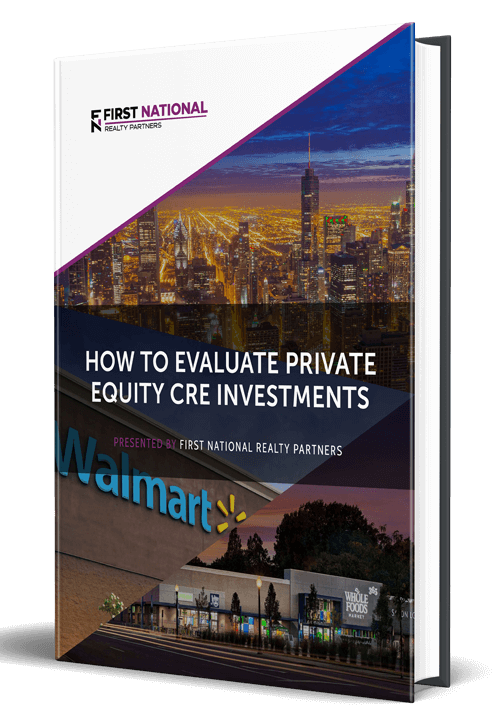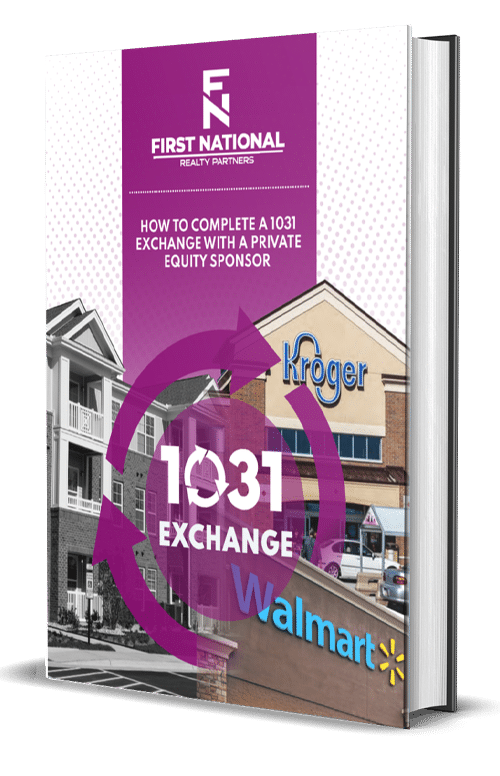The profitable sale of a commercial real estate investment property is a double-edged sword. On one hand, the property owner is happy that they were able to sell their asset for a profit. But, that profit can also come with a big tax bill from the IRS when it comes time for the investor to file their tax return. Fortunately, there is a strategy, known as a 1031 Exchange, that investors can use to minimize or defer their tax liability when they sell a property.
In this article, FNRP provides a complete guide to 1031 Exchanges for commercial real estate investors. We will describe what a 1031 Exchange is, when to use them, the types of 1031 Exchanges available to investors, the risks and benefits of using a 1031 Exchange, and the rules that must be followed when completing one.
At First National Realty Partners, we specialize in the acquisition and management of grocery store anchored retail centers. In the normal course of our business, we work with many investors looking to place their 1031 Exchange funds. If you are an Accredited Investor and would like to learn more about how we can help facilitate a 1031 Exchange, click here.
1031 Exchange Definition
A 1031 Exchange, sometimes called a “Like Kind Exchange,” is a tax deferral strategy used by experienced investors to defer tax liability/income tax on the profitable sale of an investment property.
The “1031” in the 1031 Exchange name refers to the section of the Internal Revenue code that permits such exchanges. The code states “…no gain or loss shall be recognized on the exchange of real property held for productive use in a trade or business or for investment if such real property is exchanged solely for real property of like kind…”
In other words, the capital gains taxes on a profitable sale can be deferred as long as the sale proceeds from the “relinquished property” (the property being sold) are reinvested into a “replacement property” (the new property being purchased) that is considered to be “like kind.”
Types of Properties Eligible for 1031 Exchanges
A 1031 Exchange can be completed with any commercial real estate property type, including multifamily/apartment buildings, retail, industrial or office. Under certain circumstances, a 1031 Exchange can also be used with a primary residence, vacation homes, or rental property, but these exchange transactions are complicated and the exception to the rule. Business property cannot be exchanged.
How Long Can Taxes Be Deferred?
In theory, an investor can defer taxes indefinitely by completing a series of successive 1031 Exchanges. This type of tax deferral can provide a powerful incentive for continued real estate investment, but a 1031 Exchange must be done correctly and within the bounds of the tax code to receive the full tax benefits.
1031 Exchange Example
To explain what a 1031 Exchange is, it is helpful to set the stage with a typical investment scenario.
Suppose that an investor purchased a property for $1MM and IRC accounting rules allowed them to take $20M per year in depreciation. At the end of a five year holding period, the investor sells the property for $1.25MM and the “cost basis,“ after depreciation, falls to $900M. The difference between the sales price of $1.25MM and the cost basis of $900M, or $350M, is considered to be a gain and is taxable. Depending on unique aspects of the deal, the tax bill could be as high as 25%. A 1031 Exchange could allow investors to defer this bill indefinitely.
When Should An Investor Use a 1031 Exchange?
Commercial real estate investors should pursue a 1031 Exchange when one or more of the following criteria are met:
- They about to sell a property that will result in a large capital gain;
- They have a long-term time horizon that will allow them to benefit from the tax deferred growth of their capital; or
- They have already or feel confident that they can identify a suitable replacement property within the required time limits.
It is, however, important to note that every investor’s financial situation is unique. To ensure that a 1031 Exchange is suitable, it is a best practice to consult a CPA or tax advisor before venturing down this road.
Types of 1031 Exchanges and How They Work
There are four major types of 1031 Exchanges, and the mechanics of how they work vary slightly.
1. Delayed Exchange
The most traditional type of 1031 Exchange is a “delayed exchange,” where the original property is sold first and then a replacement property is purchased second.
In a delayed exchange, an investor has 45 days from the date of sale to identify a suitable replacement property and then 180 days to close on the purchase of it.
This is the option that most investors prefer, but it is common to encounter some challenges finding a replacement property in such a short period of time.
2. Reverse Exchange
A reverse exchange happens in the reverse order of a delayed exchange.
In a reverse exchange, an investor purchases the replacement property first and then has 45 days to identify the property they plan to sell and 180 days to complete the sale of it.
The reason that an investor would take this approach is that they found a replacement property that they really want and don’t want to take the chance that the property won’t be around in the future.
3. Simultaneous Exchange
In a simultaneous exchange, the relinquished property is sold and the replacement property is purchased on the same day. The closing for each property happens “simultaneously,” so investors don’t have to worry as much about the time constraint on finding a replacement property.
This type of 1031 Exchange is most common when the investor has already identified the replacement property that they want to purchase and has come to an agreement on the purchase price.
4. Construction Exchange
A construction exchange allows the property owner to improve on the replacement property by using tax-deferred dollars to update the replacement property while held by a qualified intermediary for the remainder of the 180 day exchange period.
There are three requirements to defer all of the gain (from the sale of the relinquished property) and instead use it as part of the construction or improvement exchange:
- The entire exchange equity must be spent on completed improvements or as down payment by the 180th day;
- The taxpayer must receive “substantially the same property” that they identified by the 45th day; and
- The replacement property must be equal or greater in value when it is deeded back to the taxpayer, while the improvements must be in place before the taxpayer can take the title back from the qualified intermediary.
A construction exchange is most useful when the taxpayer has a desire or need to complete renovations to the replacement property.
1031 Exchange Rules
In order to achieve full tax deferral, the fine print of section 1031 outlines a series of rules and requirements that must be met to do a 1031 Exchange. They include (but are not limited to):
Like Kind Test
The replacement property must meet the “like kind” test, which states that the property must be “of the same nature or character” as the relinquished property. In addition, the replacement property must be located in the United States and held for “productive use in a trade or business or for investment.” It should be noted that the rules do not make a distinction between property types. So, for example, an office building could be 1031 exchanged for an apartment building and would still meet the “like kind” test.
Time Frame
From the sale date of the relinquished property, potential replacement properties must be identified within 45 calendar days (the “identification period”), and the purchase of the replacement property must be completed within 180 calendar days. This is a relatively short time frame, and competition for the best 1031 exchange properties can be stiff, so it is important to get started early and use a real estate broker if necessary.
Value
1031 Exchange rules state that the market value and equity of the replacement property must be the same as, or greater than, the value of the relinquished property. For example, a property with a value of $5M and a mortgage of $3M must be exchanged into a property with a purchase price of at least $5M with $3M worth of debt. If it isn’t, the difference could be taxable.
No “Boot”
The term “boot” refers to any non-like kind property received in a 1031 Exchange. For example, boot could take the form of cash, installment notes, debt relief, or personal property, and it is valued at “fair market value.” If boot is received, it doesn’t disqualify the exchange, but it could make it taxable.
Held For Sale
The replacement property cannot be “held for sale.” In other words, it can’t be purchased for the tax deferral benefits and then immediately sold. 1031 Exchange rules do not define a specific period of time that the replacement property must be held for, but it is generally agreed that a minimum of 12-24 months is a best practice.
Same Taxpayer
The taxpayer associated with the relinquished property must be the same as the one associated with the replacement property. In addition, both properties need to be similarly titled.
Depending on the unique circumstances of the transaction, the exchanger may seek to use one of four 1031 Exchange types: delayed exchange/deferred exchange, reverse exchange, simultaneous exchange, or construction exchange.
Types of 1031 Exchange Structures
From a legal and structural standpoint, there are a number of ways that a 1031 Exchange can be completed. Three of the most common are described in this section.
1. Single Owner/Taxpayer
In many cases, a 1031 Exchange is completed by a single owner of the property. In this structure, there is one individual who owns the original property, and they sell it and acquire the replacement property on their own.
The main advantage to the single owner/taxpayer structure is that it is simple, clean, and provides the taxpayer with maximum control over the exchange process.
The downside is that there may be a limit to the size and complexity of the properties purchased because they are constrained by the amount of the individual’s financial resources.
2. Tenancy in Common
Tenancy in common (TIC) is a structure that allows individual investors to purchase a share of a larger asset as the replacement property in the 1031 Exchange.
The benefit of the tenancy in common approach is that the investor can purchase a share of an institutional quality asset, which may be better for their portfolio over the long term. In addition, tenants-in-common property may be managed by a third party, which makes this a passive approach.
The downside is that this approach makes for a more complex transaction, and the investor may have to pay fees to a third party manager, which can cut into profits.
3. Delaware Statutory Trust
The Delaware Statutory Trust (DST) structure is very similar to the TIC structure in the sense that it allows the investor to purchase a fractional share of a larger property. However, the legal structure is slightly different.
The benefit of a DST is the same: investors can get into a higher quality asset that can potentially deliver more consistent returns.
Likewise, the downside is that DST‘s are typically managed by a third party that charges fees for their services.
1031 Exchange Benefits
Aside from the obvious tax deferral advantages, there are a number of ancillary benefits that real estate investors can realize from using a 1031 Exchange:
1. Diversification
1031 Exchange rules do not require a one-for-one swap, which means that they can be used as a vehicle for increasing the diversification of a real estate investor’s portfolio. Specifically, section 1031(k)-1(c)(4) of the code states that “…the maximum number of properties that a taxpayer may identify is:
- Three properties without regard to the fair market values of the properties (the 3-property rule), or
- Any number of properties as long as their aggregate fair market value…does not exceed 200% of the aggregate fair market value of all relinquished properties (the 200% rule).”
2. Tax Deferred Growth
Using a 1031 Exchange to defer taxes on profitable investments allows for the tax-free/tax-deferred growth of investment capital. With each exchange, the investor is able to purchase a more expensive property than they would have been able to if taxes were paid.
3. Property Replacement
Instead of investing significant sums into the renovation of an existing property, a 1031 Exchange can be a way to replace a physically obsolete property with a newer, more efficient one.
1031 Exchange Risks
Although the benefits of a 1031 Exchange can be substantial, there are a number of risks that an investor should be aware of.
1. Exchange Not Completed Correctly
The primary risk in a 1031 Exchange is that it isn’t completed correctly and the mistake causes the transaction to become taxable. For example, if a replacement property is not identified within the allocated time period or the transaction runs into delays and it cannot be closed within 180 days, the deferment could be nullified and taxes must be paid.
2. Qualified Intermediaries are Unregulated
The other major risk to consider is the use of a third party “qualified intermediary.” These are experts in 1031 Exchanges and they are employed to act as a facilitator for buyers and sellers. As part of their responsibility, qualified intermediaries actually facilitate the exchange of property titles between the buyer and seller. In addition, they hold exchange proceeds in escrow until the proceeds are needed to purchase the replacement asset.
In other words, qualified intermediaries play a critical role in the transaction, but they are unregulated by the Federal Government and receive little oversight from any other regulatory body or trade association. Although rare, it is not unheard of for a qualified intermediary to go out of business or to engage in fraudulent behavior that puts the exchange (and the investor’s capital) at risk.
What is a Qualified Intermediary?
A 1031 Exchange is a complicated transaction. If any of the rules are violated, the transaction could become taxable, which means that the investor is back on the hook for some or all of the capital gains tax bill.
To ensure that the rules are followed and to maximize the chances that the transaction runs smoothly, it is a best practice to employ the services of an individual or firm to act as a “qualified intermediary.“
A qualified intermediary, sometimes referred to as an accommodator or facilitator, is an individual, entity, or financial institution, that assists in the facilitation of a 1031 Exchange.
More specifically, a Qualified Intermediary is further defined in 26 CFR § 1.1031(k)-1(g)(4), which states that a qualified intermediary is a person who:
- (A) Is not the taxpayer or a disqualified person (as defined in paragraph (k) of this section), and
- (B) Enters into a written agreement with the taxpayer (the “exchange agreement”) and, as required by the exchange agreement, acquires the relinquished property from the taxpayer, transfers the relinquished property, acquires the replacement property, and transfers the replacement property to the taxpayer.
Qualified Intermediaries can be found through an internet search or from a referral from other investors.
Summary of 1031 Exchanges
- A 1031 Exchange is a commercial real estate transaction that allows an investor to defer capital gains taxes on the profitable sale of a property.
- There are four types of 1031 Exchanges that are common: the Delayed Exchange, Reverse Exchange, Simultaneous Exchange, and Construction Exchange.
- In order to complete a 1031 Exchange correctly, there are a number of rules that must be followed. For example, the investor must identify a replacement property within 45 days of sale and close on the purchase of it within 180 days. The complete rules are outlined in section 1031 of the Internal Revenue Code.
- Depending on the circumstances, there are a number of legal structures under which a 1031 Exchange can be completed. The most common include the individual investor, Tenants in Common (TIC), and Delaware Statutory Trust (DST).
- The major benefits of a 1031 Exchange include tax deferral, portfolio diversification, and the replacement of an older property with a newer one.
- The potential downsides of a 1031 Exchange is that they can be complicated and it can be challenging to identify a suitable replacement property within the amount of time required.
- To ensure that all 1031 Exchange rules are followed and that the transaction runs smoothly, it is a best practice to work with a qualified intermediary to complete the exchange.
Interested In Learning More?
First National Realty Partners is one of the country’s leading private equity commercial real estate investment firms. With an intentional focus on finding world-class, multi-tenanted assets well below intrinsic value, we seek to create superior long-term, risk-adjusted returns for our investors while creating strong economic assets for the communities we invest in.
We have a significant amount of experience in dealing with 1031 Exchange related transactions. Whether you’re just getting started or searching for ways to diversify your portfolio, we’re here to help. If you’d like to learn more about our middle market retail investment opportunities, contact us at (800) 605-4966 or info@fnrealtypartners.com for more information.






